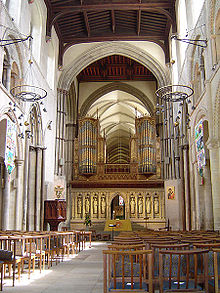Rochester Cathedral
| Rochester Cathedral | |
|---|---|
 Exterior of Rochester Cathedral | |
 | |
| Country | England |
| Denomination | Church of England |
| Website | www.rochestercathedral.org |
| Administration | |
| Province | Canterbury |
| Diocese | Rochester |
Rochester Cathedral, or the Cathedral Church of Christ and the Blessed Virgin Mary, is a Norman church in Rochester, Kent. The bishopric is second oldest in England: only Canterbury is older.
History
It was founded by Justus, one of the missionaries who accompanied Saint Augustine to convert the pagan English to Christianity in the early 7th century. As the first bishop of Rochester, Justus was given permission by King Ethelbert of Kent to establish a church of St Andrew the Apostle (the same dedication as the monastery in Rome from which St Augustine and St Justus had set out for England) on the site of the present cathedral, which was made the home of a bishopric. The cathedral was to be served by a college of secular priests and was endowed with land near the city called Priestfield.

The cathedral and city suffered much from the Mercians (676) and the Danes, but retained its importance, so much so that, when William of Normandy conquered England in 1066, he gave the church and its estates to his brother, Odo of Bayeux. The church was reduced to near-destitution, a situation only remedied in 1082 when Lanfranc, Archbishop of Canterbury visited and restored some of its lands and staff. Gundulf, the Norman Bishop of Rochester, also played a very active role; a talented architect himself, the bishop commissioned and probably had a major part in designing a new cathedral to replace Justus' church. He also replaced the secular chaplains by Benedictine monks, translated the relics of St Paulinus to a silver shrine that became a place of pilgrimage, obtained several royal grants of land, and proved a great benefactor to his cathedral city. By the time of his death he had built the nave and Western front, the Western transept being added between 1179 and 1200 and the Eastern transept during the reign of Henry III. The cathedral is small, being only 306 feet long, but its nave is the oldest in England and it has a fine Norman crypt.
The present building is widely regarded as one of the finest Norman cathedrals in the country, with a particularly fine doorway at its western (main) entrance. The tympanum depicts Christ sitting in glory in the centre, with Justus and Ethelbert flanking him on either side of the doorway.
After Gundulf's death, the cathedral had a somewhat chequered history. In 1130 the cathedral was consecrated by the Archbishop of Canterbury, assisted by thirteen bishops in the presence of Henry I, but the occasion was marred by a great fire which nearly destroyed the whole city and damaged the new cathedral. It was badly damaged by fires again in 1137 and 1179. It was then looted in 1215 by the forces of King John and again in 1264 by Simon de Montfort, during sieges of the city and its castle.
However, besides the shrine of St Paulinus, the cathedral contained the relics of St Ithamar, the first Saxon to be consecrated bishop, and of St William of Perth, a murdered Scottish pilgrim. In 1201 the offerings at St William's tomb were so great, that by their means the choir was rebuilt and the central tower was added (1343), thus completing the cathedral.
The cathedral suffered a steep decline after the Dissolution of the Monasteries in the 16th century, during which time its estates were confiscated by the Crown, and it became dilapidated and disreputable. Samuel Pepys, the diarist, dismissed it as a "shabby place". It underwent several restorations in the 19th century the principal works were carried out by Lewis Nockalls Cottingham from 1824 to 1830 followed by Sir George Gilbert Scott who took on the task in 1872, renovating the cathedral and restoring it to a reasonable facsimile of its original 11th century condition.
Rev. GM (Grevile Marais) Livett, the longtime precentor of Rochester Cathedral and later vicar of Wateringbury, authored several books and monographs on the Norman churches of England, as well as contributing extensively to the Archaeologica Cantiana (The Journal of the Kent Archaeology Society).[1][2][3] (Livett's name was a variant of Levett, an old Sussex and Kentish family.)
Archdeacons of Rochester
Rochester Cathedral's Archdeacons have included:
- Dr. John Kennall LL.D. 1556 -1559
- Rev. Dr. Thomas Plume, B.A., D.D., founder of the Plume Library, Maldon, Essex, and the Plumian Professor of Astronomy and Experimental Philosophy at the University of Cambridge.
- Rev. Dr. Walker King, M.A., D.D., father of the Rt. Rev. Edward King, Bishop of Lincoln.
Music
Organ
The pipe organ is by J. W. Walker & Sons. A specification of the organ can be found on the National Pipe Organ Register.
Organists
|
|
|
Assistant Organists
- Percy Whitlock (1921 - 1930)
- David Poulter
- Paul Hale
- William Whitehead (1994 - 1998)
- Dan Soper
See also
- List of cathedrals in the United Kingdom
- Architecture of the medieval cathedrals of England
- English Gothic architecture
- Romanesque architecture
- Church of England
- Textus Roffensis
